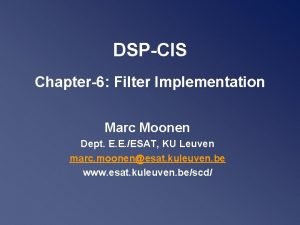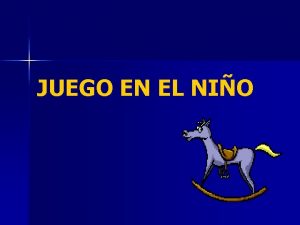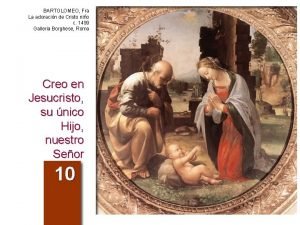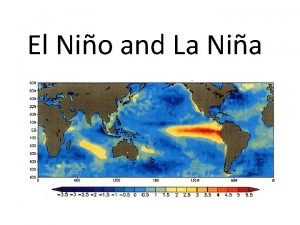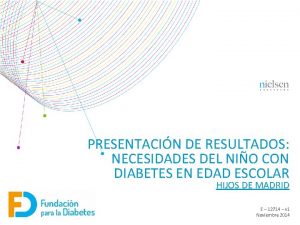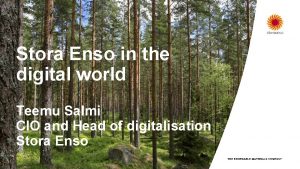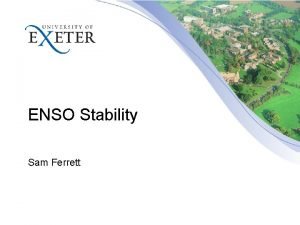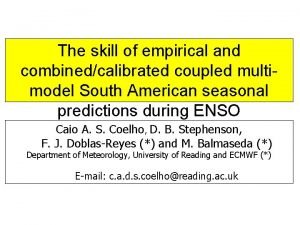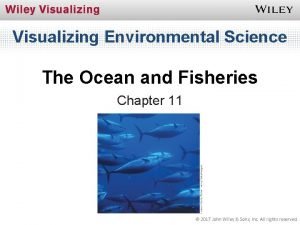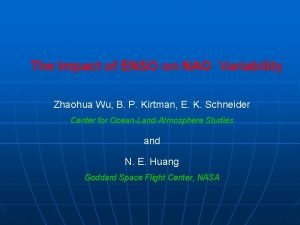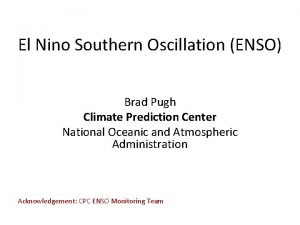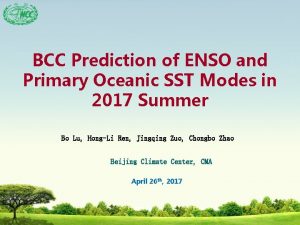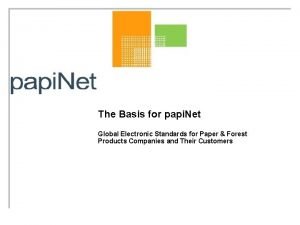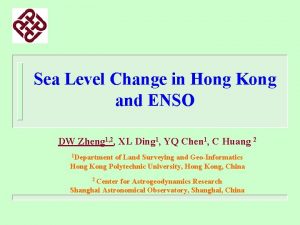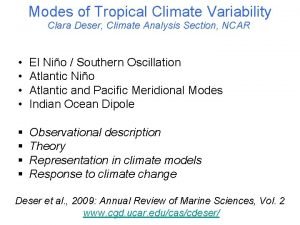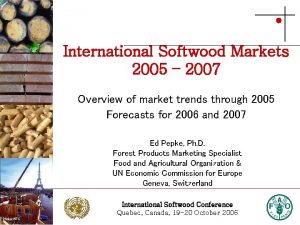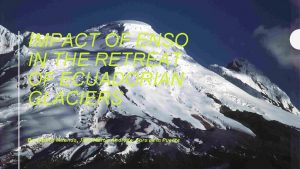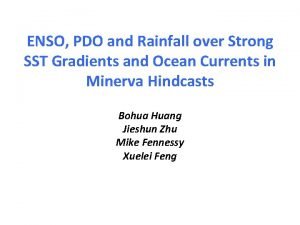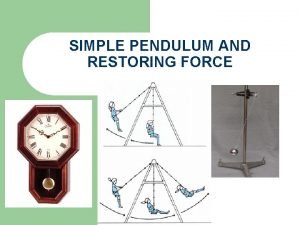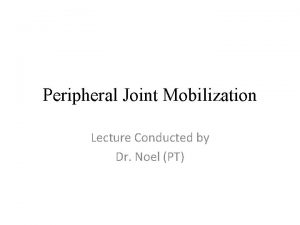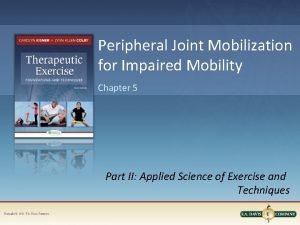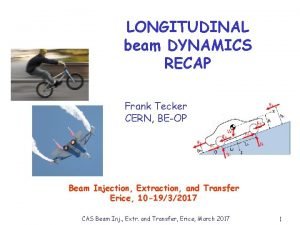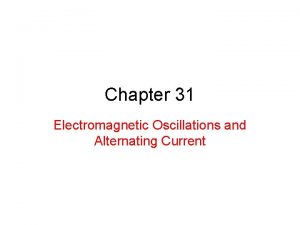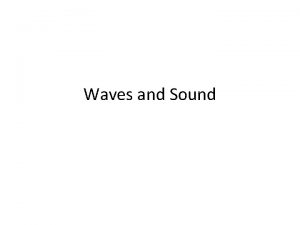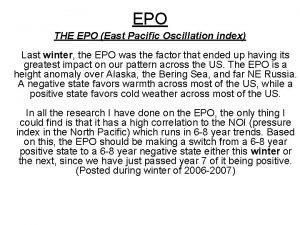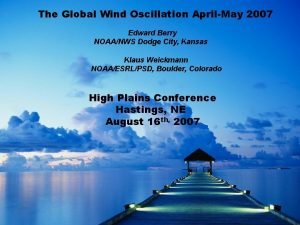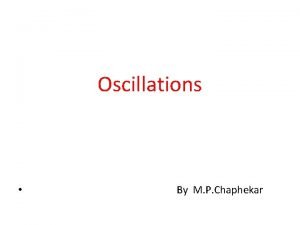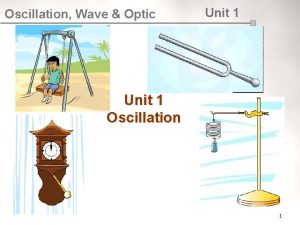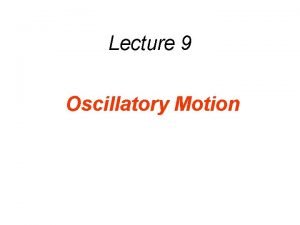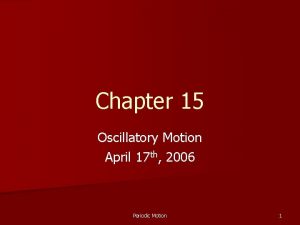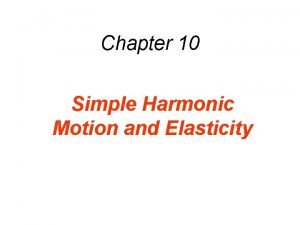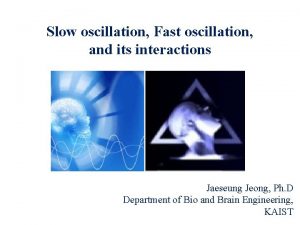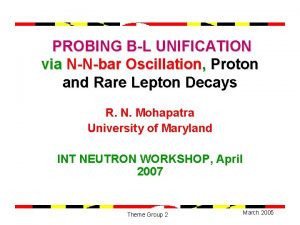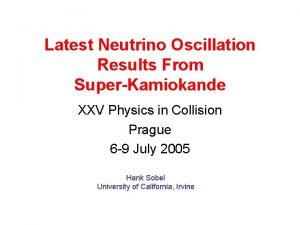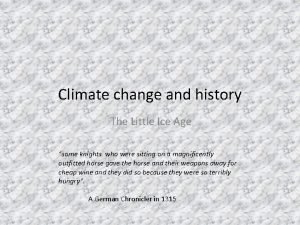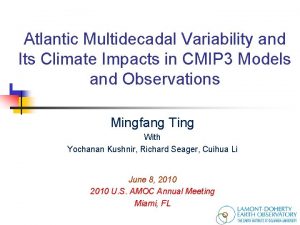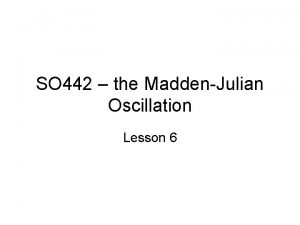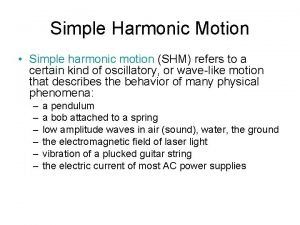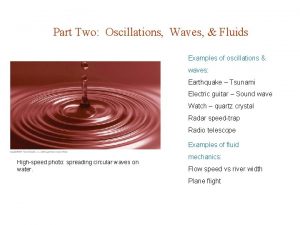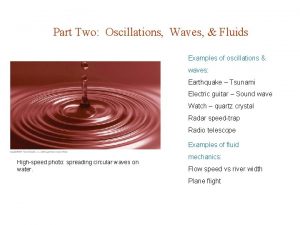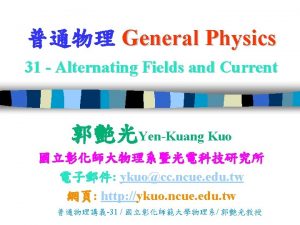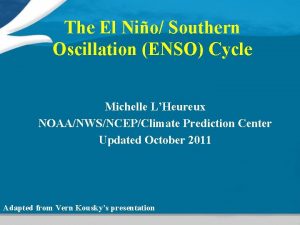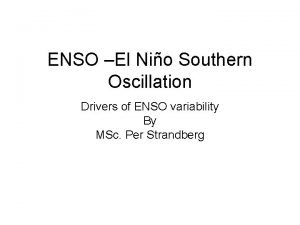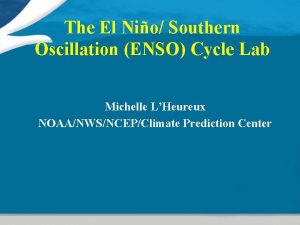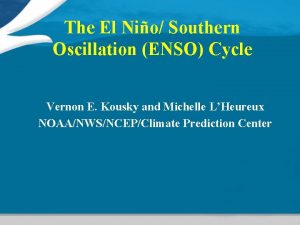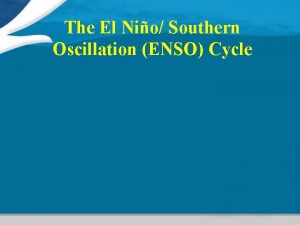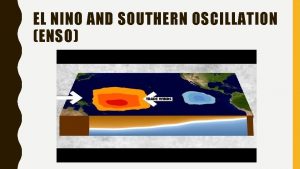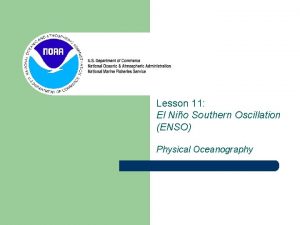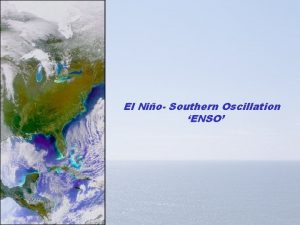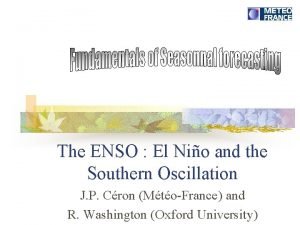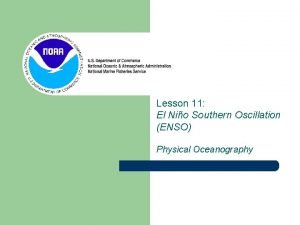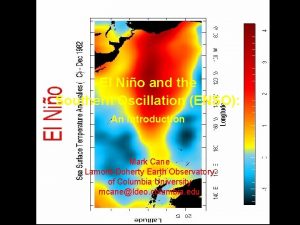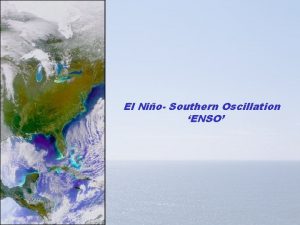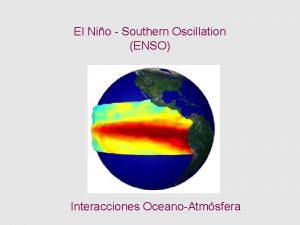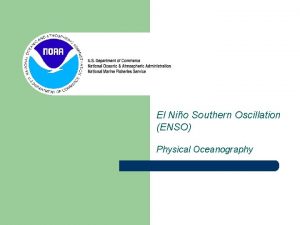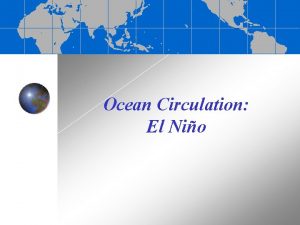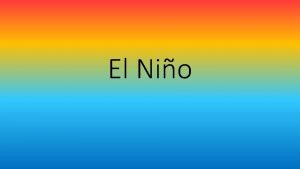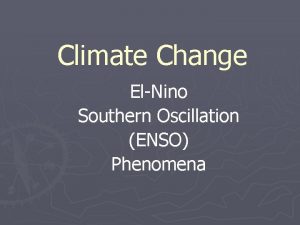The El Nio Southern Oscillation ENSO Cycle Michelle







































































- Slides: 71

The El Niño/ Southern Oscillation (ENSO) Cycle Michelle L’Heureux NOAA/NWS/NCEP/Climate Prediction Center Adapted from Vern Kousky’s presentation

Outline (1) Seasonal Cycle of Sea Surface Temperature and Precipitation (2) El Niño - Southern Oscillation (ENSO): Historical Context (3) Comparison between El Niño/ Low SO Phase VS. La Niña/ High SO Phase (4) The ENSO Cycle: A Coupled Ocean- Atmosphere System (5) Evolution of Previous ENSO Cycles (6) ENSO Teleconnections and Global Impacts (7) Upper-level Circulation Changes over the Pacific and North America (8) Application to ENSO Monitoring and Prediction at NOAA Climate Prediction Center (CPC)

Sea Surface Temperature (SST): Major Features • Equatorial cold tongues prominent in the eastern Pacific and Atlantic (strongest during the SH winter/spring – July-October) • Globally, tropical waters are warmest during the NH late winter and early spring seasons • North-south seasonal shifts of warm tropical waters are observed in the western portions of tropical oceans

SST: Major Features Atlantic Warm Pool Pacific Warm Pool Cold Tongues

SST: Extremes in the Annual Cycle Equatorial SSTs are warmest in April Equatorial cold tongues are strongest in Jul. -Oct.

SST Animation

Precipitation Global precipitation analyses based on station data and satellite-derived estimates • Greatest precipitation over warm surfaces where ample moisture is available, and in areas of mid-latitude storm activity – Tropical land masses – Intertropical Convergence Zones (ITCZs) – South Pacific Convergence Zone (SPCZ) – South Atlantic Convergence Zone (SACZ) – Mid-latitude winter storm tracks

Precipitation: Major Features Storm Tracks ITCZ SPCZ SACZ

Precipitation: Major Features • Least precipitation in regions lacking moisture or featuring pronounced subsidence, and in colder regions – – Equatorial cold tongues Deserts Subtropical high pressure systems High latitudes

Precipitation: January vs. July

Precipitation Animation

Outline (1) Seasonal Cycle (Sea Surface Temperature and Precipitation) (2) El Niño - Southern Oscillation (ENSO): Historical Context (3) Comparison between El Niño/ Low SO Phase VS. La Niña/ High SO Phase (4) The ENSO Cycle: A Coupled Ocean- Atmosphere System (5) Evolution of Previous ENSO Cycles (6) ENSO Teleconnections and Global Impacts (7) Upper-level Circulation Changes over the Pacific and North America (8) Application to ENSO Monitoring and Prediction at NOAA Climate Prediction Center (CPC)

History of El Niño • El Niño, as a oceanic phenomenon along the coasts of northern Peru and Ecuador, has been documented since the 1500 s. • Originally, the term El Niño was used to describe the annual appearance of warm waters around Christmastime. • In some years the warm waters appeared earlier and lasted longer. Eventually, the term El Niño was used to describe these periods of anomalous warming. • The stronger events disrupted local fish and bird populations

History of the Southern Oscillation • Beginning in the late 1800 s scientists began to describe large-scale pressure fluctuations. • Sir Gilbert Walker and colleagues extended the early studies and established that a global-scale pressure fluctuation (the Southern Oscillation) is related to rainfall anomalies in many areas of the Tropics (e. g. , India and South America. • The SO was used as the basis for seasonal rainfall predictions (ca 1930 s).

Discovery of the “El Niño. Southern Oscillation (ENSO)” • El Niño and the Southern Oscillation were studied as separate phenomena until the 1950 s-1960 s. • Important works by Berlage (1956) and J. Bjerknes (late 1960 s) demonstrated a link between the two phenomena. • Studies at that time also showed that the anomalous warming of the waters during El Niño extended over a large portion of the equatorial Pacific.

The ENSO Cycle • Naturally occurring phenomenon • Equatorial Pacific fluctuates between warmer-than-average (El Niño ) and colder-than-average (La Niña) conditions • The changes in SSTs affect the distribution of tropical rainfall and atmospheric circulation features (Southern Oscillation) • Changes in intensity and position of jet streams and storm activity occur at higher latitudes

Outline (1) Seasonal Cycle (Sea Surface Temperature and Precipitation) (2) El Niño - Southern Oscillation (ENSO): Historical Context (3) Comparison between El Niño/ Low SO Phase VS. La Niña/ High SO Phase (4) The ENSO Cycle: A Coupled Ocean- Atmosphere System (5) Evolution of Previous ENSO Cycles (6) ENSO Teleconnections and Global Impacts (7) Upper-level Circulation Changes over the Pacific and North America (8) Application to ENSO Monitoring and Prediction at NOAA Climate Prediction Center (CPC)

El Niño/ Low Southern Oscillation Phase VS. La Niña/ High Southern Oscillation Phase Signals in Tropical Pacific: • Sea surface temperatures (SSTs) • Precipitation • Sea Level Pressure • The Southern Oscillation (High vs. Low Phases) • Low-level Winds and Thermocline Depth

Sea Surface Temperatures Equatorial cold tongue is weaker than average or absent during El Niño, resulting in positive SST anomalies Equatorial cold tongue is stronger than average during La Niña, resulting in negative SST anomalies

Precipitation Enhanced rainfall occurs over warmerthan-average waters during El Niño. Reduced rainfall occurs over colderthan-average waters during La Niña.

Sea Level Pressure El Niño: Positive SLP anomalies over the western tropical Pacific, Indonesia and Australia. Negative SLP anomalies over eastern tropical Pacific, middle and high latitudes of the North Pacific, and over U. S. Opposite pattern for La Niña. The pressure see-saw between the eastern and western tropical Pacific is known as the Southern Oscillation.

Southern Oscillation – High Index Phase (La Niña) Equatorial Easterlies – stronger than average SLP – below average D Low Enhanced Precipitation T High SLP – above average

Southern Oscillation – Low Index Phase (El Niño) Equatorial Easterlies – weaker than average SLP – above average D Low Reduced Precipitation T High SLP – below Enhanced Precipitation average

Low-Level Winds & Thermocline Depth La Niña: stronger-than-average easterlies lead to a deeper (shallower)-than-average thermocline in the western (eastern) eq. Pacific. El Niño: weaker-than-average easterlies lead to a deeper (shallower)-than-average thermocline in the eastern (western) eq. Pacific.

Outline (1) Seasonal Cycle (Sea Surface Temperature and Precipitation) (2) El Niño - Southern Oscillation (ENSO): Historical Context (3) Comparison between El Niño/ Low SO Phase VS. La Niña/ High SO Phase (4) The ENSO Cycle: A Coupled Ocean- Atmosphere System (5) Evolution of Previous ENSO Cycles (6) ENSO Teleconnections and Global Impacts (7) Upper-level Circulation Changes over the Pacific and North America (8) Application to ENSO Monitoring and Prediction at NOAA Climate Prediction Center (CPC)

ENSO: A Coupled Ocean. Atmosphere Cycle ENSO is a “coupled” phenomenon: atmosphere drives the ocean and the ocean drives the atmosphere. “Positive Feedback” between ocean and atmosphere. Example: Weaker equatorial trade winds cold water upwelling in the east will decrease surface warming of the ocean reduced east-west temperature gradient Weaker equatorial trade winds

What is “Normal? ” Warm Cold (2) Warm water heats the atmosphere and makes it rise, so low-level trade winds blow towards warm water to fill the gap. Subsiding air occurs in the eastern basin. Winds and Sea Surface Temperature are COUPLED. The SSTs determine the winds and vice versa. (1) Easterly trade-winds help push warm water to the western Pacific and upwell cold water in the eastern Pacific Ocean. Warm Cold

“El Niño” Warm Cold NOTE: Location of the warmest SSTs (>28°C) determines where tropical convection will be located. • Convection shifts eastward over the central and/or eastern Pacific Ocean. Convection becomes suppressed over the far western Pacific/ Indonesia. • Easterly trade winds weaken • Thermocline deepens and the cold water upwelling decreases in the eastern Pacific. Warm Cold

“La Niña” Enhanced More Convection Stronger Upwelling Warm Cold • Convection becomes stronger over the far western Pacific Ocean/ Indonesia and more suppressed in the central Pacific. becomes more shallow • Easterly trade winds strengthen • Thermocline becomes more shallow and the cold water upwelling increases in the eastern Pacific. Warm Cold

Outline (1) Seasonal Cycle (Sea Surface Temperature and Precipitation) (2) El Niño - Southern Oscillation (ENSO): Historical Context (3) Comparison between El Niño/ Low SO Phase VS. La Niña/ High SO Phase (4) The ENSO Cycle: A Coupled Ocean- Atmosphere System (5) Evolution of Previous ENSO Cycles (6) ENSO Teleconnections and Global Impacts (7) Upper-level Circulation Changes over the Pacific and North America (8) Application to ENSO Monitoring and Prediction at NOAA Climate Prediction Center (CPC)

Typical Evolution of the ENSO Cycle • Irregular cycle with alternating periods of warm (El Niño) and cold (La Niña) conditions • El Niño tends to occur every 3 -4 years and generally lasts 12 -18 months • Strongest El Niño episodes occur every 10 -15 years • La Niña episodes may last from 1 to 3 years • Transitions from El Niño to La Niña are more rapid

The Evolution of Equatorial SST Anomalies: 1982 -1990 1982 -83 El Niño 1984 -85 La Niña 1986 -87 El Niño 1988 -89 La Niña

Evolution of the ENSO Cycle: 1982 -1990 El Niño: Positive SST anomalies, enhanced precip, weaker than average easterly winds La Niña: Negative SST anomalies, reduced precip, stronger than average easterly winds

Thermocline Depth: 19821990 Thermocline depth (upperocean heat content) anomalies lead SST anomalies

Animation of Subsurface Temperatures: 1996 -1999

SST Animation: 1997 -1998

Outline (1) Seasonal Cycle (Sea Surface Temperature and Precipitation) (2) El Niño - Southern Oscillation (ENSO): Historical Context (3) Comparison between El Niño/ Low SO Phase VS. La Niña/ High SO Phase (4) The ENSO Cycle: A Coupled Ocean- Atmosphere System (5) Evolution of Previous ENSO Cycles (6) ENSO Teleconnections and Global Impacts (7) Upper-level Circulation Changes over the Pacific and North America (8) Application to ENSO Monitoring and Prediction at NOAA Climate Prediction Center (CPC)

ENSO Teleconnections Tropical convection/heating can lead to “wavetrains” that can influence the global circulation. EXAMPLE: Eastward expansion of warm sea surface temperatures during El Niño can result in an anomalous eastward shift of convection. Enhanced thunderstorm activity in the central Pacific will perturb the upperlevel flow resulting in an anticyclonic “couplet” straddling the equator. Poleward of the ridge, an anomalous trough forms in the central North Pacific Ocean. Schematic from Horel and Wallace (1981)

Global El Niño Impacts are generally more extensive during the northern winter.

Typical Global El Niño Impacts Region Indonesia Northeast Brazil Central America /Mexico West Coast South America Central South America Southeast Africa Period Life of event March-May May-October Impact Drier March-May Wetter June-December Wetter December-February Drier

Anomalous Precip. (mm/d): Strong El Niño Episodes Rainfall departures, as large as ± 8 mm/d (30 inches in a season), result in changes in the pattern of tropical heating, and changes in the positions and intensities of midlatitude jet streams and planetary waves.

Anomalous Precip. (mm/d): Moderate El Niño Episodes Rainfall departures are less during weak/ moderate warm episodes. Smaller changes occur in the pattern of tropical heating, and in the midlatitude jet streams and planetary waves.

Global La Niña Impacts Mid-latitude impacts generally occur during the winter season (NH – DJF; SHJJA).

Typical Global La Niña Impacts Region Period Impact Indonesia Northeast Brazil Central America /Mexico West Coast South America Central South America Southeast Africa Life of event March-May May-October Wetter March-May Drier June-December Drier December-February Wetter

Anomalous Precip. (mm/d): La Niña Episodes Rainfall departures, as large as ± 8 mm/d (30 inches in a season), result in changes in the pattern of tropical heating, and changes in the mid-latitude jet streams and planetary waves.

Outline (1) Seasonal Cycle (Sea Surface Temperature and Precipitation) (2) El Niño - Southern Oscillation (ENSO): Historical Context (3) Comparison between El Niño/ Low SO Phase VS. La Niña/ High SO Phase (4) The ENSO Cycle: A Coupled Ocean- Atmosphere System (5) Evolution of Previous ENSO Cycles (6) ENSO Teleconnections and Global Impacts (7) Upper-level Circulation Changes over the Pacific and North America (8) Application to ENSO Monitoring and Prediction at NOAA Climate Prediction Center (CPC)

Typical Upper-Level Circulation Changes over the North Pacific and North America • El Niño: Jet stream over North America is stronger than average and shifted equatorward. Flow is more zonal than average from the central Pacific eastward across the U. S. • La Niña: Jet stream over North America is shifted poleward from its normal position. Flow is more meridional than average over the central and eastern Pacific.

Upper-level Winds: El Niño

Upper-level Winds: La Niña

Upper Level Winds El Niño Episodes

Upper Level Winds La Niña Episodes

North Ameri can jet stream El Niño La Niña

Typical Impacts of El Niño on North America and the Atlantic Basin • North American summer monsoon region (northern Mexico) – drier than average • U. S. Pacific Northwest fall and winter -- drier than average • Atlantic hurricane season: suppressed activity • Gulf Coast states and, in strong events, central and southern California winter -- wetter than average • Northern Plains, Pacific Northwest, Southern Alaska, and western and central Canada -- warmer than average

Typical Impacts of La Niña on North America and the Atlantic Basin • North American summer monsoon region (northern Mexico) – wetter than average • U. S. Pacific Northwest fall and winter -- wetter than average • Atlantic hurricane season: enhanced activity • Southeast U. S. , Gulf Coast states and central and southern California winter -- drier than average • Southwest and Southeast U. S. -- warmer than average

Outline (1) Seasonal Cycle (Sea Surface Temperature and Precipitation) (2) El Niño - Southern Oscillation (ENSO): Historical Context (3) Comparison between El Niño/ Low SO Phase VS. La Niña/ High SO Phase (4) The ENSO Cycle: A Coupled Ocean- Atmosphere System (5) Evolution of Previous ENSO Cycles (6) ENSO Teleconnections and Global Impacts (7) Upper-level Circulation Changes over the Pacific and North America (8) Application to ENSO Monitoring and Prediction at NOAA Climate Prediction Center (CPC)

Application to Monitoring and Forecasting at NOAA CPC • A sampling of atmospheric and oceanic ENSO indices: SOI, Nino-1+2, Nino-3. 4, Nino-4, ONI • NOAA CPC definitions for ENSO • ENSO Alert System • Forecasting ENSO and its Impacts on the United States • Climate Change and ENSO

Tahiti-Darwin SOI Darwin Tahiti

Niño Regions Largest positive anomalies occur in the eastern equatorial Pacific (Niño 1+2 and 3 regions). Negative anomalies have roughly the same magnitude in all regions.

NOAA Operational ENSO Definition • The Oceanic Niño Index (“ONI”) is based on SST departures from average in the Niño 3. 4 region, and is a principal measure for monitoring, assessing, and predicting ENSO. • ONI is defined as the 3 -month running-mean SST departures in the Niño-3. 4 region. Departures are based on a set of improved homogeneous historical SST analyses (Extended Reconstructed SST – ERSST. v 3 b). El Niño: characterized by a positive ONI greater than or equal to +0. 5°C. La Niña: characterized by a negative ONI less than or equal to − 0. 5°C. To be classified as a full-fledged El Niño or La Niña “episode” these thresholds must be exceeded for a period of at least 5 consecutive overlapping 3 -month seasons.

ONI: Evolution since 1950

CPC Working Definition for ENSO • The Oceanic Niño Index (ONI) is used to put current events in historical context. Because it is calculated as a 3 -month running mean SST departure it is a “lagging” index, which works better in a retrospective fashion. • For real-time use, CPC uses “conditions: ” El Niño conditions: one-month positive SST anomaly of +0. 5 or greater in the Niño-3. 4 region and an expectation that the 3 -mth ONI threshold will be met. La Niña conditions: one-month negative SST anomaly of − 0. 5 or less in the Niño-3. 4 region and an expectation that the 3 -mth ONI threshold will be met. AND An atmospheric response typically associated with El Niño/ La Niña over the equatorial Pacific Ocean. The ENSO Alert System is based on El Niño and La Niña “conditions” that allows CPC to be able to issue watches/advisories in real-time.

ENSO Alert System: Types of Alerts An El Niño or La Niña Watch: Issued when the environment in the equatorial Pacific basin is favorable for the development of El Niño or La Niña conditions within the next three (3) months. An El Niño or La Niña Advisory: Issued when El Niño or La Niña conditions in the equatorial Pacific basin are observed and expected to continue. Final El Niño or La Niña Advisory: Issued after El Niño or La Niña conditions have ended. NA: The ENSO Alert System will not be active when El Niño or La Niña conditions are not observed or expected to develop in the equatorial Pacific basin.

What triggers an ENSO Watch or Advisory? • The ENSO Alert System is based on El Niño and La Niña “conditions” that allows CPC to be able to issue watches/advisories in real-time. • “Conditions” requires a 1 -month SST value and corresponding atmospheric response, along with the expectation that the 3 month threshold (ONI) will be met. • NOAA’s official Oceanic Niño Index (ONI) is not used to trigger a Watch or Advisory because it is calculated as a 3 -month running mean SST departure. It is a “lagging” index, which puts ENSO events in a historical context.

Example of Alert System Status CPC’s ENSO Diagnostic Discussion and Climate Diagnostics Bulletin are the primary vehicles used to disseminate real-time information concerning the ENSO Alert System status to the scientific community and general public. User can click on status to get detailed information on Alert System definitions http: //www. cpc. noaa. gov/products/ analysis_monitoring/enso_advisory /ensodisc. html

Forecasting ENSO Forecasters rely on: (1) Real-time data from the equatorial Pacific Ocean (collected from buoys, satellites, etc) and their knowledge of previous ENSO episodes (2) Dynamical models: mathematical equations combined with current observations and run on a computer - NCEP Climate Forecast System (CFS): a “coupled” computer model (ocean and atmosphere interact) (3) Statistical models: use observations of past to make predictions of the future - Consolidated Forecast Tool (“CON”): statistically combines different models to take advantage of independent information provided each model the by

How well do models predict ENSO? • Statistical and Dynamical models have comparable forecast skill. • Models have trouble with transition timing and predicting amplitude of ENSO events. • Stronger ENSO events tend to be better predicted than weaker ones. • “Spring barrier: ” historically, forecasts before the Northern Hemisphere Spring have low skill. • Intraseasonal variability (i. e. MJO) is not captured in most of these models and these phenomenon can have considerable impact on ENSO evolution.

How well do models predict ENSO? NCEP Climate Forecast System (CFS) Model Figure courtesy of Wanqiu Wang, NOAA CPC IC= “Initial Condition”

Forecasting ENSO-related Impacts http: //www. cpc. ncep. noaa. gov/products/precip/ CWlink/ENSO/composites/

Forecasting ENSO-related Impacts http: //www. cpc. ncep. noaa. gov/products/precip/ CWlink/ENSO/composites/

Climate Change and ENSO • IPCC-AR 4: “No consistent indication at this time of discernible changes in projected ENSO amplitude or frequency in the 21 st century. ” - ENSO projections differ from model to model - Continued ENSO variability in the future even with changes to the background state Fig. 10. 16 from Chapter 10 IPCC AR 4

Summary • ENSO is a naturally occurring phenomenon • Equatorial Pacific fluctuates between warmer-than-average (El Niño ) and colder-than-average (La Niña) conditions • The changes in SSTs affect the distribution of tropical rainfall and atmospheric circulation features (Southern Oscillation) • Changes in intensity and position of jet streams and storm activity occur at higher latitudes
 Enso cycle
Enso cycle Limit cycle oscillation in dsp
Limit cycle oscillation in dsp Piaget juego simbolico
Piaget juego simbolico Dr nio
Dr nio Nio fra
Nio fra Nia nio
Nia nio Nio presentacion resultados
Nio presentacion resultados Teemu salmi
Teemu salmi What is enso?
What is enso? Enso counseling
Enso counseling Stora enso harjoittelu
Stora enso harjoittelu Visualizing environmental science solution manual
Visualizing environmental science solution manual Enso
Enso El nino enso
El nino enso Enso
Enso Papinet
Papinet Enso hk
Enso hk Eñso
Eñso Enso international
Enso international Enso stands for
Enso stands for Minerva pdo
Minerva pdo Different method of size sepration are
Different method of size sepration are One oscillation pendulum
One oscillation pendulum Indication and contraindication of mobilization
Indication and contraindication of mobilization Non-thrust oscillation techniques
Non-thrust oscillation techniques What is the amplitude of the oscillation
What is the amplitude of the oscillation Joint play grading
Joint play grading Electromagnetic oscillation pdf
Electromagnetic oscillation pdf Disturbance or oscillation
Disturbance or oscillation Mechanical oscillation
Mechanical oscillation Bifilar oscillation is the example of mcq
Bifilar oscillation is the example of mcq East pacific oscillation
East pacific oscillation Oscillation mecanique
Oscillation mecanique Global wind oscillation
Global wind oscillation General equation of shm
General equation of shm Units for period of a pendulum
Units for period of a pendulum Two examples of periodic motion
Two examples of periodic motion Damped oscillation
Damped oscillation Simple harmonic motion and elasticity
Simple harmonic motion and elasticity Slow oscillation
Slow oscillation Oscillation
Oscillation Oscillation
Oscillation North atlantic oscillation
North atlantic oscillation Amo atlantic multidecadal oscillation
Amo atlantic multidecadal oscillation Julian oscillation
Julian oscillation Time period of shm
Time period of shm Maximum speed of simple harmonic oscillator
Maximum speed of simple harmonic oscillator Forced oscillation
Forced oscillation Oscillation
Oscillation Rlc oscillation
Rlc oscillation Hát kết hợp bộ gõ cơ thể
Hát kết hợp bộ gõ cơ thể Bổ thể
Bổ thể Tỉ lệ cơ thể trẻ em
Tỉ lệ cơ thể trẻ em Gấu đi như thế nào
Gấu đi như thế nào Chụp phim tư thế worms-breton
Chụp phim tư thế worms-breton Bài hát chúa yêu trần thế alleluia
Bài hát chúa yêu trần thế alleluia Các môn thể thao bắt đầu bằng tiếng nhảy
Các môn thể thao bắt đầu bằng tiếng nhảy Thế nào là hệ số cao nhất
Thế nào là hệ số cao nhất Các châu lục và đại dương trên thế giới
Các châu lục và đại dương trên thế giới Công thức tiính động năng
Công thức tiính động năng Trời xanh đây là của chúng ta thể thơ
Trời xanh đây là của chúng ta thể thơ Mật thư tọa độ 5x5
Mật thư tọa độ 5x5 Làm thế nào để 102-1=99
Làm thế nào để 102-1=99 Phản ứng thế ankan
Phản ứng thế ankan Các châu lục và đại dương trên thế giới
Các châu lục và đại dương trên thế giới Thể thơ truyền thống
Thể thơ truyền thống Quá trình desamine hóa có thể tạo ra
Quá trình desamine hóa có thể tạo ra Một số thể thơ truyền thống
Một số thể thơ truyền thống Cái miệng bé xinh thế chỉ nói điều hay thôi
Cái miệng bé xinh thế chỉ nói điều hay thôi Vẽ hình chiếu vuông góc của vật thể sau
Vẽ hình chiếu vuông góc của vật thể sau Biện pháp chống mỏi cơ
Biện pháp chống mỏi cơ

